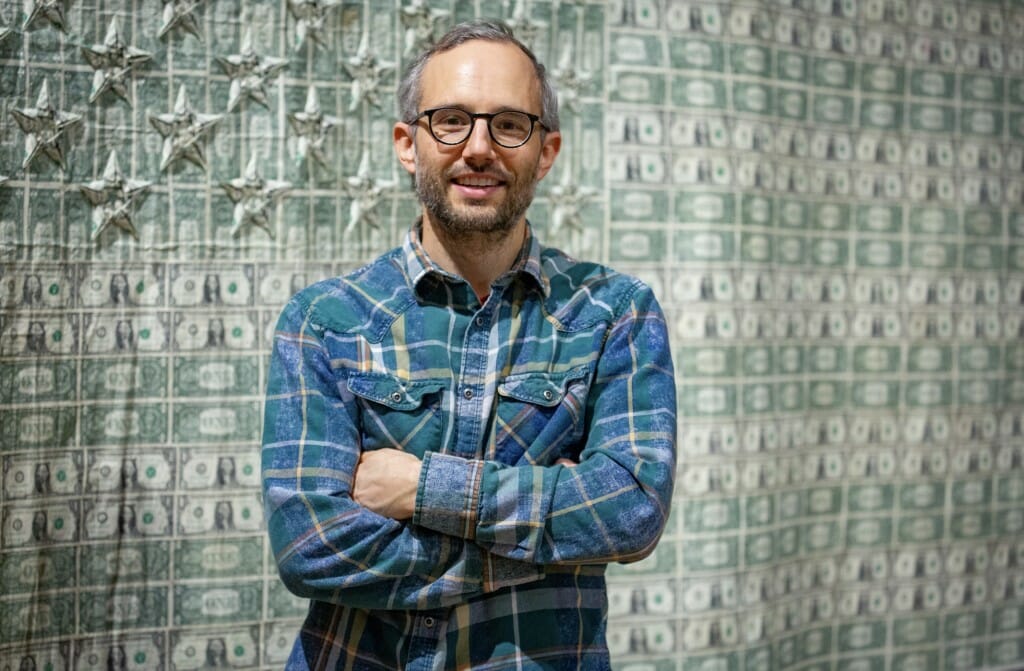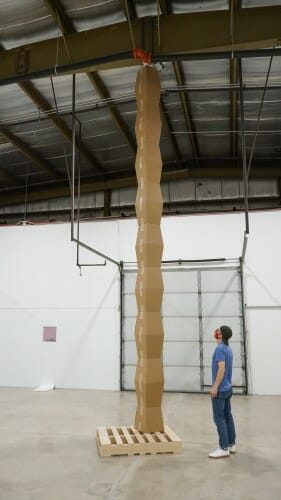Award-winning sculpture inspired by pandemic staple: “Tower of Boxes”

Keith Kaziak
At the start of the pandemic, Keith Kaziak found an unusual inspiration for a new sculpture.
The UW–Madison art graduate student and sculptor had to clear out of his studio in March 2020 and work from his spare bedroom.
“We were ordering a lot of orders through Amazon, and I began collecting those boxes and cataloging them,” he said. “I started doing small mock-ups at home and that’s how it evolved.”
It became a sculpture titled “Tower of Boxes,” composed of cardboard, rigid foam, wood-grain contact paper, fiber-reinforced tape, and adhesive.

Kaziak’s “Tower of Boxes”
“All of the pieces were separate [and] I glued them together so they were all connected on the inside,” Kaziak said, “essentially all I needed was an eight-foot ladder to assemble this piece.”
For his work, Kaziak was awarded the International Sculpture Center’s 2021 Outstanding Student Achievement in Contemporary Sculpture Award, one of only 11 winners nationwide.
Kaziak, who is pursuing an MFA degree, is a sculptor and educator; he’s been the UW–Madison Interdisciplinary Artist Research Cohort Fellow for three years.
Kaziak wanted “Tower of Boxes” to be relatable.
“My choice of materials were common, ubiquitous, sort of vernacular construction-based materials things that most people can relate to,” he said.
He noted the ways in which the pandemic both inspired and influenced his work.
“I started thinking about how walls were isolating us during this time,” Kaziak said, “I was seeing the wall as also being isolated, so normally the galleries would be open and people would be walking around and looking at art. People can kind of relate to some of those notions.”
Kaziak said the sculpture’s form was inspired by Constantin Brâncuși “Endless Column,” which was an important form in art history and a pivotal point in modern art.
“Brâncuși’s work was what a lot of people would refer to as ‘site-specific work,’ and a lot of my work is about my relationship to space or site,” Kaziak said. “All of my work for that show related to my studio space [and] was a direct response to architectural nuances and features… and so there’s a strong relationship that I have to that form.”
Kaziak seeks inspiration from various art history movements.
“[There is] a broad collection of artists that I really enjoy and oftentimes emulate or borrow from… so I’m really interested in including art history into that conversation when I can.” Kaziak said. “I really sort of fell in love with periods of time in art history that I probably dismissed as a younger student.”
Kaziak was nominated for the award by an art professor, and submitted three pieces.
“I was kind of surprised actually,” Kaziak said, “I think I’m always a little cautious about how I feel about my own work.”
There were also worries about physically submitting his art. The rules said pieces shouldn’t exceed 10 feet in any direction, and “Tower of Boxes” exceeded that substantially. “The way that I got around that was that I just said the piece had ‘variable dimensions.’”
Another piece he submitted, “Creep,” was part of a wall in the gallery. “So I wasn’t really sure how practical that piece would’ve been, in terms of shipping and maybe having the gallery cut a hole in their wall.”
An exhibition displaying the winning artists’ work is scheduled for this autumn in Detroit.
“It sounds like all of my work will get shipped there and then there’ll be like an opening ceremony,” Kaziak said, “[Detroit] has its own interesting history… I think it would be a cool place to go and I’d be excited to be part of this group exhibition there.”
Kaziak said he’s learned from past mistakes in his art career.
“I found that I embraced chance and risk, and I see failure as valuable,” Kaziak said, “[and] often I’ll find myself going back to these ideas years later, and maybe I wasn’t supposed to do it then but and here I am coming full circle going right back to something.”
